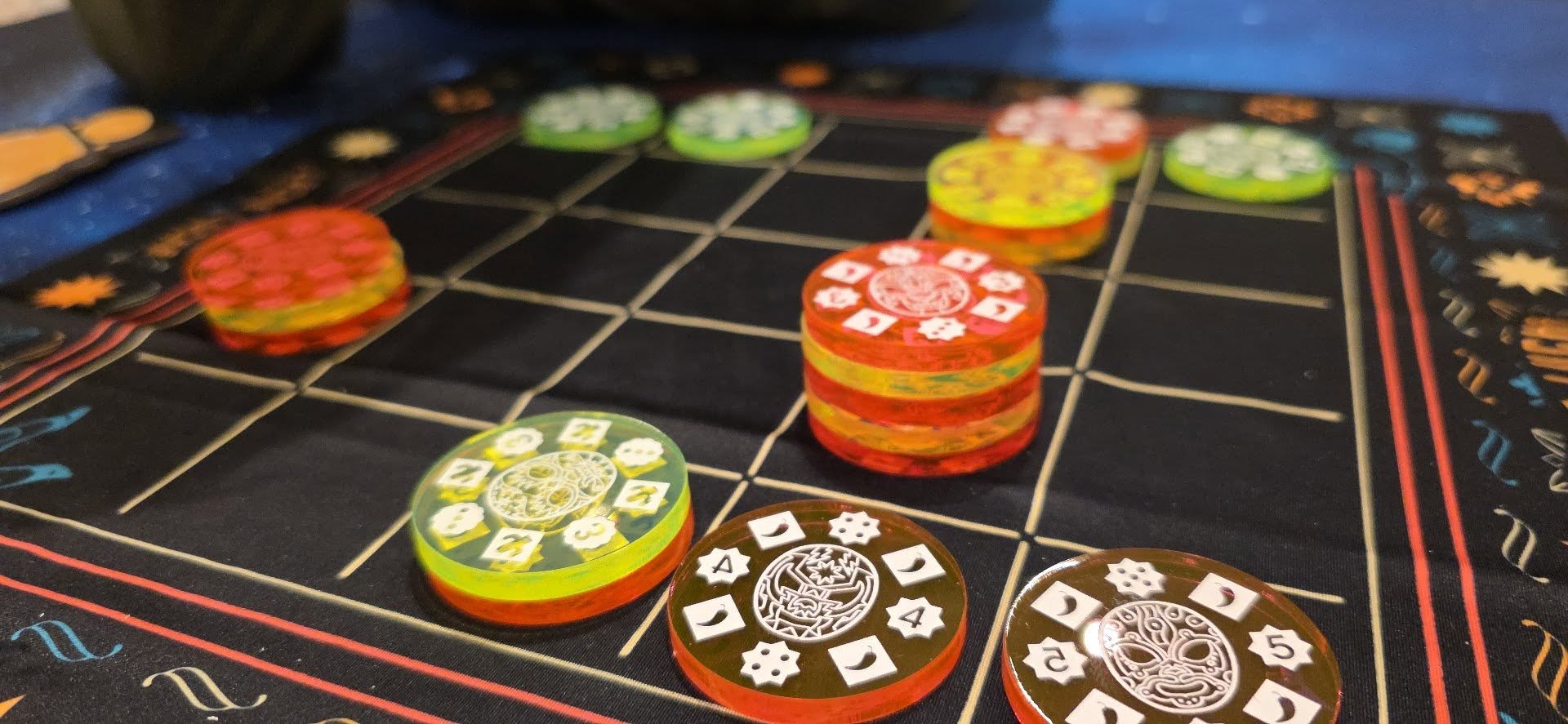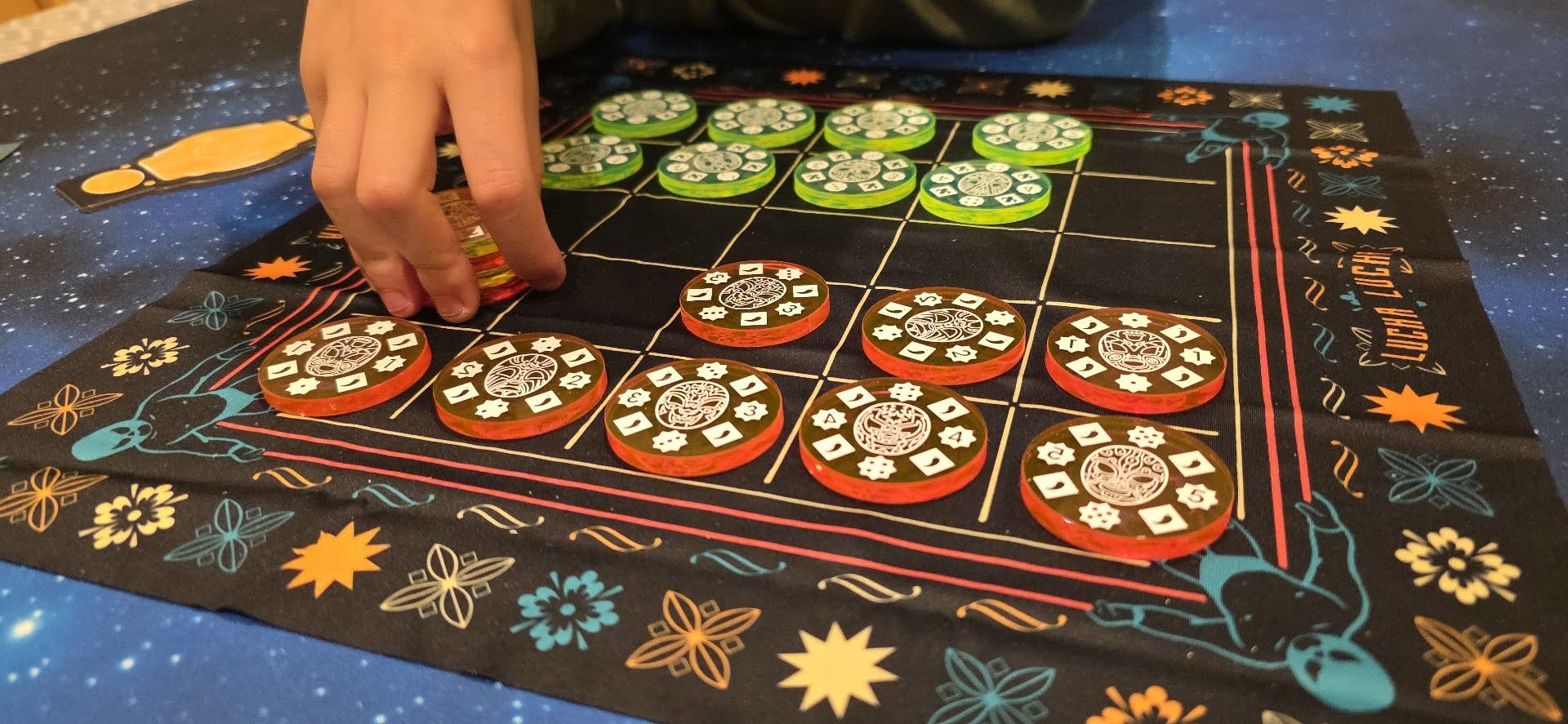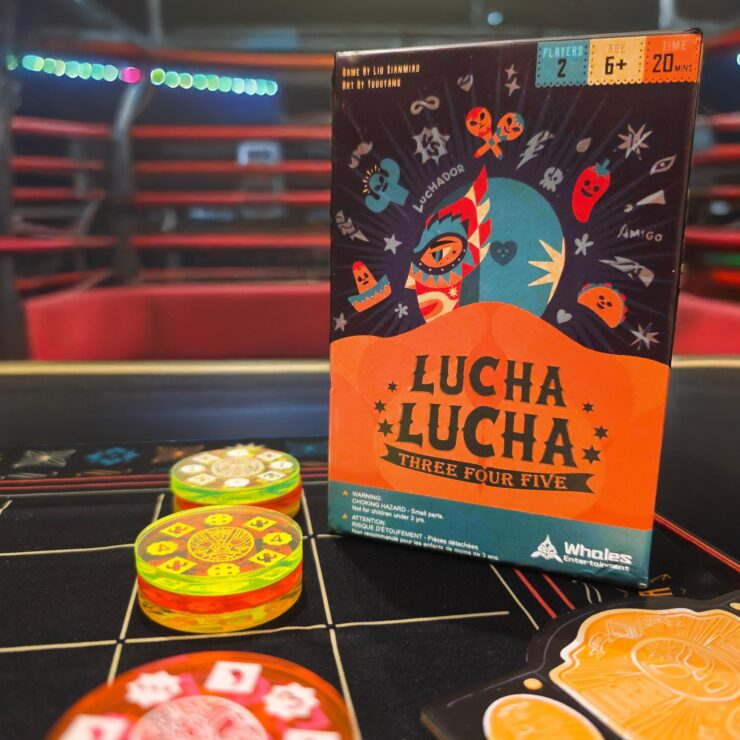Today we’re going to be looking at Lucha Lucha 345!, a 1v1 abstract strategy game themed around the spectacle of Lucha Libre wrestling.
Outside of board games and video games, one of my other biggest passions is professional wrestling. Having grown up in the early 90s watching WWF and WCW with my grandma, this is something that has always been very important to me, and as I’ve grown older I have also developed a passion for other cultures such as strong style wrestling (very prominent in the UK and Japan) as well as Lucha Libre from Mexico. Therefore, I was really excited to try this out.
As is common with Whales Entertainment games, the board is actually cloth and you lay it down on the table. One of the things I like about this the most (and I didn’t mention in my Tailor Master review) is that by having a cloth board you can actually make the size of the box itself much smaller, which is a massive plus.
Each player then lays out their discs into rows: one row going from left to right ascending and one row going from left to right descending.

The whole game revolves around the concept of stacks. If your disc is on the top of the stack you control that stack, and you can move that stack around. On your turn you can move your stack anywhere on the board to a piece that you can reach by moving orthogonally as many spaces as you like.
After moving your stack (or single disc) and placing your disc(s) on top of your opponent’s stack, what happens depends on whether your number is higher, lower, or the same as the number of your opponent’s. If the strength of your number is lower than the opponent’s then the stack stays as it is and your number stays on top. If the number is higher than your opponent’s you turn the stack upside down, and the stack is now the number of the bottom piece of the original stack, regardless of whether that is your disc or your opponent’s. Finally, if the strength of your stack is equal, then you can decide whether you want to flip it or not.
This is where the main strategy comes in. What you are essentially trying to do is manipulate the discs and manipulate the stacks so that by the end of the game you end up with your discs on top — potentially sending your disc to the bottom knowing full well that it’s going to end up on the top further down the line.
![May be an image of text that says "BINOSTARO4 BOHOBTAB LETHAL FANG LETHALFANG BLUEL LEGEND BLUELEGEND 米 DEVI GOLDEN SAINT After youre ば如の outroma BLUE DEVIL YOU nиuxy have advantoge Piect Piec キ· ary ετριγ youma your hange itto your Luchat lock]. Tackle- pieces wont Ulimate SkciNi [Deadlock]. untimateskdiu-Biputen Tackie-down]. down]. -EXPULPO Jh0 tcd wo eort b tiea HN นอง benas foresor."](https://littleboardgamers.com/wp-content/uploads/2025/09/546852766_10100532998789883_3413846520681853799_n.jpg)
It’s a really simple concept, but actually it requires a lot of thought. The strategy and forward thinking involved in this to be successful makes it one of the most high-thinking abstract strategy games I’ve played in a long time. Obviously, you can play this simply and hope for the best, but to be really good at it is going to require a lot of practice as well as an element of social deduction.
To make this more interesting, you are limited in how many stacks of three, four and five you can have, with each player only being allowed to have stacks that are three, four, and five. Any move that would result in a stack being three, four, or five is not allowed if there is already a three, four, or five stack of yours on the board. This can be beneficial both offensively and defensively.
When a player is unable to attack another player’s stack the game is over, and you work out how much crowd support you have. The cheers, as they describe them in the game, are worked out based on the top disc of the stack number multiplied by the amount of pieces in that stack. So if your number four is on the top and there are three discs of yours in the stack, you would end up with 12 points for that stack.

This is the basic game mode, but there are also advanced rules that involve using cards based on Lucha Libre wrestlers in order to have special powers and do special things. I really like these as they allow for a slightly more in-depth game and in a weird way I think actually take a little bit of pressure off some of the high-end thinking, as you can manipulate things a little bit easier than having to think really complex and far in advance.
The characters are original designs, but for someone who is familiar with Mexican wrestling, both from modern day with companies like CMLL and AAA as well as famous Lucha Libre wrestlers from the past, you will definitely notice some homages to real life wrestlers.
The box is a really nice size, the cloth ring is a really nice touch, and the discs are laser-cut fluorescent acrylic which allows you to see the numbers on the discs regardless of which size they are. It’s a super small downside, but if like us you are the sort of people that like to take the plastic protective layer off the acrylic discs, Jack and I found this extremely hard — and it probably took us longer to take the plastics off the discs than it took us to have our first game. Bear in mind though, if this is one of my biggest moans it’s probably all gone quite well.
Lucha Lucha 345! is a solid abstract strategy game that I would definitely recommend. This isn’t going to be for absolutely everyone and, if I’m being honest, the actual Lucha Libre theme is very much theme-only and doesn’t really play into the mechanics almost at all — but I do appreciate the nice artwork.
For abstract strategy fans though, this is a solid choice.














